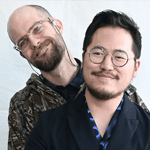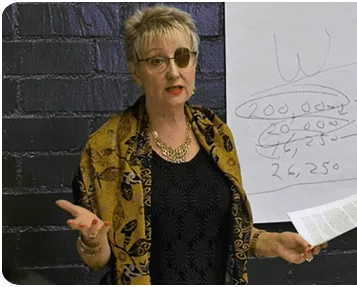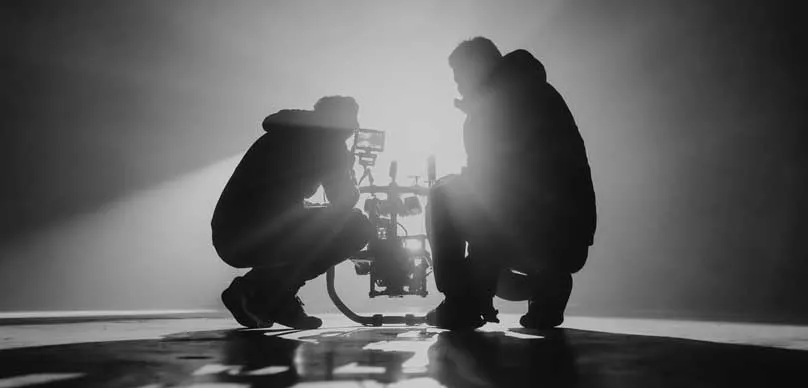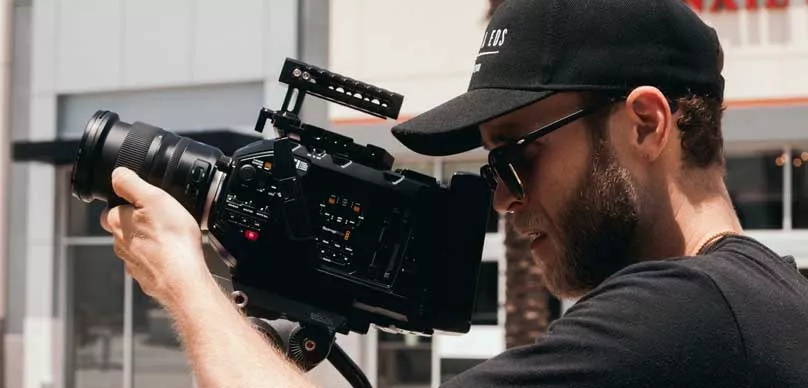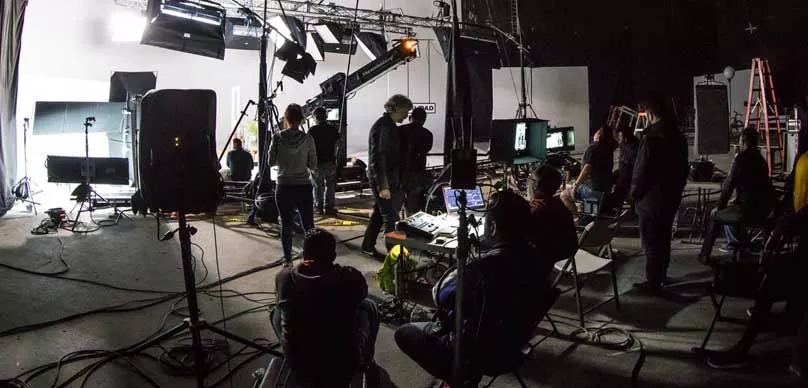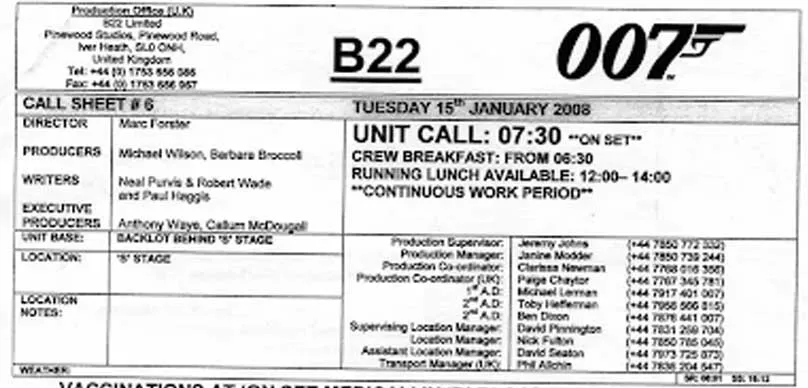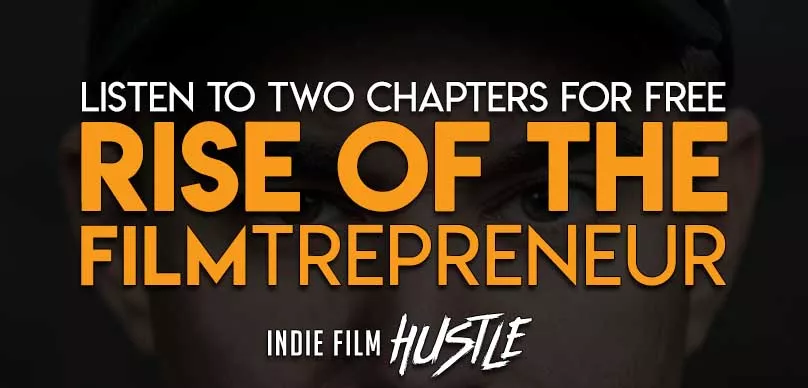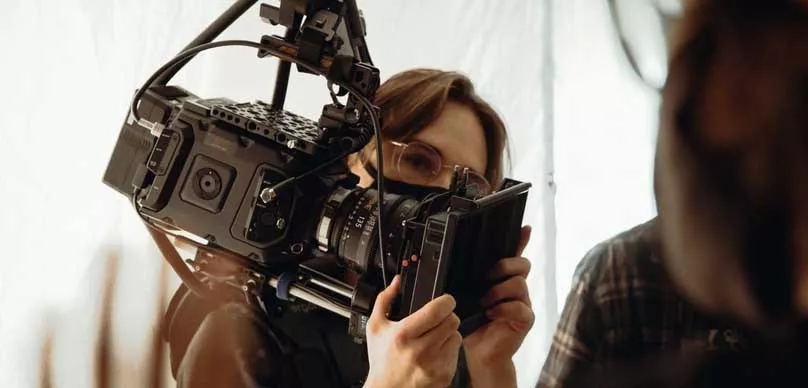What if indie filmmakers could access the same virtual production systems used on the hit Disney+ show The Mandalorian? What if you could use that same technology at home for your productions? What if it cost less than most RED Camera packages? Today’s guest wants to do exactly that. Rene Amador is the co-founder and CEO of the virtual production tech company ARWall.
Rene boasts 24 years of working with 16 startups, starting young working for his parent’s startups in silicon valley. He’s also directed over 350 commercials, short films, and pilots. Most recently as co-founder at ARwall, Rene won the SXSW Accelerator 2018 AR/VR category pitch, has been acknowledged as a top AR tech evangelist in Hollywood, and designed the first ARwall Lab in Burbank.
Rene and his team have developed a professional virtual production system that filmmakers can use at home powered by the most powerful real-time graphic engine on the market. How does this all work you may ask? ARFX requires a tracker and at least two sensors installed on set.
Once the tracker is calibrated and attached to the camera, the director of photography has the ability to move anywhere inside the tracked space. The virtual scene runs on the system updates in perfect real-time, no matter where the camera is positioned. This creates a seamless window illusion into the virtual space.
Filmmakers really put this tech to the test on Disney+’s Star Wars show The Mandalorian. If you haven’t seen this show do yourself a favor and get a monthly subscription to Disney+, sit back and enjoy.
I also recommend you watch The Gallery, a behind-the-scenes show on how they made The Mandalorian.
I’m not saying a newcomer to the filmmaking process will just be able to pick up this tech and make The Mandalorian but the tools are there for filmmakers who are ready to make that leap.
This is a massive jump in how filmmakers tell their stories. ARWall’s Home Studio is the next jump for indie filmmakers. The cost is cheaper than most RED or ALEXA cameras.
This technology is one of the most exciting filmmaking tools to come out since digital cameras became the norm. Not only is this tech cool but the speed that it became affordable for the independent filmmaker is mind-blowing.
It took a decade before we had access to the same ground-breaking technology that was used in Jurassic Park.
Rene and I talk virtual production, The Mandalorian, the future of the AR Wall, and how indie filmmakers can start using this technology today.
Enjoy my conversation with Rene Amador.
Right-click here to download the MP3
Alex Ferrari 2:21
Now I know a lot of you have watched Disney plus his show, the Mandalorian which is a Star Wars The first Star Wars television series. And it was one of the biggest shows of last year and the new season just started last week. I am a tremendous fan, as many of you already know. But what I was really interested in was the virtual production techniques and technologies that they use and implemented to make a giant very big budget looking show on a budget now mind you on a budget is relative in the Star Wars universe. But let's just say that they were able to put together hours and hours of content for less budget than you would have to spend on a standard Star Wars movie. Now, when I looked at all of this, obviously there's a lot of talk about how this might help filmmakers and production companies deal with the Coronavirus doesn't need a lot of people, you can be very enclosed, very bubble like and you can have a lot of production value and you can save a lot of money because you don't have to do as much green screening and visual effects costs. But I was like this is all great. And again, you know, just like when the T rex showed up in Jurassic Park in 1993. That's really great. But how is that going to help us as independent filmmakers? Well, today's guest is someone who is going to help you get access to this insane technology on a budget. Now today we are speaking to Rene Amador from AR wall. And AR wall is one of the industry leaders in this virtual production technology. And when I saw their newest product, my mouth dropped to the floor they have created the AR wall home studio, which allows you as an independent creator as an independent filmmaker to use same or similar technologies to what they used on the Mandalorian at a very, very affordable price. We're talking less than the cost of a red camera. Now Rene and I get into all of the tech knology how independent filmmakers can use it, what it would do for your production value? How do you get those amazing backgrounds that you're going to be able to move left and right. I mean it is it's just an insane, insane world that we're walking into. We're that much closer to literally just shooting on a holodeck from Star Trek, which is basically an entire room that looks and feels almost like a real room. But it's all holographic. We are very, we're just getting closer and closer to eventually being able to shoot on the holodeck. And this technology is that next step forward. So without any further ado, please enjoy my conversation with Rene Amador. I'd like to welcome to the show Rene Amador. How are you doing, Rene?
Rene Amador 5:47
I'm doing just fine. Thanks for having me, Alex.
Alex Ferrari 5:49
Oh, brother, man, thank you for being on the show. Man. I truly appreciate it. I am I have to say before we get started, man, I am such a fan of what you guys are doing at AR it's it's mind blowing. Absolutely mind blowing. But we're gonna get into all of that in this episode. But before we start, I have to tell the story because we were talking about it before we got on.
Rene Amador 6:11
Yes.
Alex Ferrari 6:11
And please tell. Please tell the audience how we know each other.
Rene Amador 6:17
Yeah. So I mean, I think you reached out because we had some big press recently, we came out with some big announcements recently. And, and just this morning, I was thinking Alex Ferrari is such a familiar name is the type of name you don't forget, right? So I was thinking this sounds so familiar. I went back to my personal email from like, you know, over 10 years ago, and went and looked and put your name and found I've been on your newsletter since about 2007. And the Sigma factory, and I think it was originally because you, you were kicking butt on the DB x 100. A and then the HV x 200. And you were one of the few people that was doing visual effects intensive stuff on those cameras. So we were we wanted to use those same cameras. So we were following you to see what you're up to what your workflows were. And then that you came up with a bunch of like workshops to and I think I actually might have purchased them. Yeah, but I think the original way that I that I heard about you is we we had a we had a couple films go to Dragon Con 2007. Your your shorts were there as well. Once I saw those, and I think we were actually in contention against each other. I was like you won first prize. I won second prize. Wow, that that's awesome. Isn't that wild? Yeah. So that's how I first learned about I was like, Who the hell is this guy?
Alex Ferrari 7:41
Why is this guy Why did it Why do you get first place? What the hell's going on here? I got to watch these things.
Rene Amador 7:49
I have an email here. First email from your newsletter, June 2007. What a blast from the past.
Alex Ferrari 7:58
I was when you told me this story. I was absolutely floored. Because, first of all, I can't believe you have email from 2007. So that alone, there's issues that you need to work out. But but that and then you read the email was about my second film sin and you know, Hey, guys, I want to let you know about my new film. It is so funny how that little short film I did in 2005 people still talk to me about it and still reach like when I and it happens more often than you would think like I The last thing I thought of when I when I rang in to our interview today is you were gonna go Hey, dude, I like I remember broken like I just didn't larious That's amazing. It's pretty, pretty amazing, Matt, but thank you for sharing that insane.
Rene Amador 8:46
I'm a fan, just to be clear. And it's awesome here. You know, I'm here just to interview you. Basically.
Alex Ferrari 8:55
I'll come on your podcast or anytime you'd like the AR podcast anytime you. So how did you get into the film business in the first place, sir?
Rene Amador 9:05
Yeah, um, so I think originally, my dad, my dad wanted to be a filmmaker way back in the 70s. And I ended up going into computer engineering instead. So he, he was as one of the top software engineers for the defense industry for about 40 years. But through that entire period from even a young age, that spirit of filmmaking was still inside him. And he definitely, you know, imbued my entire upbringing, my, my, my media culture, with that love of cinema. So you know, I grew up, you know, before the age of 10, watching Fellini and Kurosawa and all these intense films. Just really just thinking like, Okay, this is just this is culture. This is what art is not really knowing that, like it's pretty unusual to get that type of education as a young child. in cinema, so at about the age of 10, I, you know, made a pretty determined statement to my family, like, I am going to be a filmmaker, I'm going to be director, you know, screenwriter and make these projects, do some TV, do some film, you know, just do what I can. And it really, I think it was a couple films that did that. For me, obviously. I think like science fiction films were pretty big for me Star Wars. But then there was one in particular, which people may laugh at, which is din, the David Lynch movie, I happened to own that, because my, my dad was pretty big, big David Lynch fan. And I don't think I'd seen any other films, the first film I'd seen of his. And when I just in the first 10 minutes of that film, you see the set design and the production design that that they brought to that project. And you just think, somebody, his job is to get paid to make the sets. And, and just to think, what, how much fun and how much amazing creativity goes into that type of collaboration. I thought that that's something I have to be involved with. Because you know, as a kid, you look out into the rest of the world. And you're like, who else is approaching that level of creativity and that level of storytelling and imagination. It's not really something that you see out in the world. So film for me was that moment where I realized dream and imagination and reality and career could all come together into one package, and really create something special. So that that's how I really got started. And then just just kind of thinking of that mentality at a very young age. And then I made my first project, obviously, for us for a heist, you know, trying to get rid of doing homework.
Alex Ferrari 11:59
I did that too. It was awesome.
Rene Amador 12:01
When make a video, we made a video. I think my first video was called Deron Gatto, it had to be in Spanish because it was for Spanish class. And it was just it's basically kind of like a Lost Highway rip off. Like some weird surreal thing where people were, you know, in dark lighting looking intense, that type of thing. And that was a lot of fun. And one of the things that happened when I was making it is literally everyone said to me, hey, you've done this before, like, I can tell that you've done this before. And I'll be like, Nope, never done that before just watched every single behind the scenes, you know, DVD thing that I could get my hands on. So that's how I got started. And then in senior year of high school, I made a very popular video called real ultimate power, the official ninja movie, which was based on their website called real ultimate power dotnet, which is very popular at the time. And that got over 3 million views that video. This was in 2002 in high school. So I personally set up the
Alex Ferrari 13:02
How'd you get the views? Where were those views? because YouTube wasn't even around yet.
Rene Amador 13:05
You're correct. So there's two things. One is it's an adaptation of a website into a video, which is something that hadn't really been done before. And in fact, we found out that the only other projects who have done at the time was something called undercover brother, which I think you may remember that was actually a website to begin with. So we were in this we were part of this little wave in the beginning of viral content, where basically we're adapting websites into video. So we we got linked on the front page of that website and that's where a lot of loaded viewership came from. However, there's a there's another component of it, which is that I was very active in 4chan in the something awful com forums, which are kind of the precursor to like read it. And unlike mean groups and that type of stuff, and actually in this something awful form groups with BPI, BYOB and FYI a D. I can't say what those mean on air No, they're acronyms people who there's something awful will know these I was a regular on these in and being able to put the content out, you know, I would be making means shareables This was 10 years before you know, eight people even knew what a meme or shareable was, I'll be making them for the film for my for putting them on the website being like, look at how ridiculous this is putting a link to the video. And that's that's how we made it have that. So we reached millions of views. And that was such a new strategy at that time. And what's funny is 10 years later, I was doing exactly that for Fox. Which is so weird. Exactly that for Fox actually for American Idol. For one of the top brands in the world. I was doing that meme and shareables creation with so going full circle, but that's really how I got started doing my own distribution setting up webhosting myself, and then back when you had to think about that type of stuff, and then that project was extremely absurdist. It was very similar, I would say. It was inspired kind of like by the Christopher Guest movies waiting for guffman that type of stuff. I'm a really big fan of Christopher Guest. Just the whole, that insane improv energy where anything can happen and that sensation of awkwardness, I kind of see him almost as the spiritual successor to Fellini in the way that he casts off oddball characters that look odd, and just give you a certain feeling. And then they go off and do something that's highly unusual or just highly tense. And it gives you such an intense narrative feeling. In those moments. I really enjoy that that type of stuff. So if you if you know that about me, a lot will make sense about my films, because they tend to have an absurdist really irreverent, and a kind of a screwball sensibility to them.
Alex Ferrari 16:02
Well, that's, that's awesome. And yeah, I did the same mean situation in 2004 2005. When I did my short films, it was it. I mean, those that was such the wild, wild west man, it was such a wild wild west back then. And I, it's hard for people to understand that, you know, you couldn't just put your film up, like us literally couldn't, there was no YouTube and even YouTube smocked in 2005, like the quality was atrocious. It's the technology just wasn't there and let alone to stream. You know, you know what I did with sin, that second film that your email, I actually, I actually wanted to sell it on iTunes, but couldn't, because there was no technology to get it up on iTunes. So what I did was, I would sell the download of an iTunes file, the M v four file or whatever the iTunes format is, I would sell it on my on my website, and then they would click dollar 99 to rent it, and then they would double click on it, it would open up in the iTunes app. Back then.
Rene Amador 17:02
Yes. I mean, I think, you know, remembering backups that time and how this how difficult distribution was online? That's a genius move. I used this, this is really going to data I use something called real player.
Alex Ferrari 17:16
Oh, I remember. Of course, the web the the flash is flash based, right? or close to Mr. Flash place, but I know for a player or Yeah, something like that. Yeah.
Rene Amador 17:26
It was JavaScript, possibly flash or you know, Shockwave or whatever the hell they had
Alex Ferrari 17:30
That shock wave. Whoo. Remember, dream weaver.
Rene Amador 17:37
So yeah, I mean, you would have to build the actual infrastructure of distribution at that time, and it was such a pain in the butt. And when YouTube came along, really, the original people not might not realize it's the original pitch that YouTube had wasn't even as a video destination, it was at as a pitch to Video Creators, hey, we'll make it super easy for you to get your video online, then you can embed it wherever you want, you know, you're there everywhere. It wasn't meant to be a destination site. It was only later when people started linking directly to the YouTube page instead of their own website with the video embedded, that it started to become a video destination site. And that was very interesting to see happen in real time.
Alex Ferrari 18:18
No, it's it's increasing. And I also by the way, I have I think, and I want someone to tell me differently, but I think I have the first filmmaking tutorials up on YouTube.
Rene Amador 18:30
I wouldn't be surprised because oh, five. Yeah, I think I bought them. And I remember it being I remember it being unusual. Like I hadn't heard like, I'm trying to think like, it was almost it almost felt infomercial, Lee, you know, like, you know, like a, you know, learn how to meditate or something, you know, you would see that kind of stuff on TV. But you didn't you know, it's not like now we're you know, masterclass and you know, how to cook and learn how to do this or that or it wasn't a common thing. And the fact that you were doing something on media creation was pretty unusual because at that point, it had just become viable to do to do like fully digital media. And then you were you had realized oh, man, like like I can, you know, do screencaps and I can do all sorts of stuff and so you were showing the entire process in an interesting way that I don't think that had been done before. Like Where did you learn how to do that? Because I don't think there's
Alex Ferrari 19:26
I was, I was a post guy did I was I was editing since 96. So I just kind of understood the the post production aspect of things and then I have a marketing head and that's how it kind of all combined that with everything else I've done in my life. It kind of came up and started doing it I always just figured out like and even then I still didn't get it because I left YouTube I should have stayed I should have stayed and it's gonna make it if I would have made tutorials just kept making tutorial videos. I would own own the filmmaking tutorials base but I bought I'm now not a teacher, I don't I'm a filmmaker. Spielberg didn't do tutorial videos. Why should I? And that was the ego spoke speaking, but who knew? No One No one knew no one knew. Exactly. But what So? So we're here to talk about your company that you've co founded AR wall. First of all, which is if I'm if I'm correct about, it's a company that deals with augmented reality, and versions of that, can you explain to people what augmented reality is?
Rene Amador 20:30
Absolutely. So we call ourselves an AR xR company, which basically means augmented reality and what they call extended reality, or some people call it mixed reality. And basically, what this means is we're combining live action elements in real time with CG elements. And it's different from traditional visual effects, which is entirely a time shifted process where you shoot and then you do the compositing at a later point. So we're, we're not, we're not in that game, we're in the game of capturing it on set live, whether it's a live stream, a live broadcast, or live to tape type of scenario, where you want to give the impression of a live broadcast. But the whole point is you walk away from set with the final shot with the final pixel. And that's a fundamental shift in the way that people have been conceiving of virtual production. Because I think, when it comes to film and TV, prior to us coming out to the scene, most people's heads were at pre visualization, which means, you know, you hire the third floor, we work who's worked on Star Wars and Avengers films, one of our one of our sister companies that that we love working with. And so you, you have a temporary composite, which isn't even meant to be like a full, like fully 100% tract composite, it's meant to be reminiscent, and just to give the the filmmakers on set, like an idea of what it's going to be like. So that's not final pixel. And that's where real time graphics have been relegated in film and TV for quite quite some time, about 10 years. When we came on the scene in 2016, there was no solution that was fast enough to do. Like the window illusion and camera tracking the way that we did. There was some stuff for experiential, unreal, had something called VR cluster. And then Barco had developed something for industrial use that use goggles with like big ping pong balls on them, that type of thing. But nobody had looked at how do you combine those experiential and industrial tools that were being developed for, for commercial purposes, into the media industry, so that you could actually get the CG in a realistic way sutured behind the live action actors with sets. So we we saw that as our original challenge. And we actually accomplish that in 2017, and immediately signed a Netflix and NBC Universal project called nightflyers, which was our first project. And to describe what we're up to here, basically, what's happening is, if you think of traditional rear projection, you have a giant screen, it's giving the sensation that the act or the sets are in a location in which they're not actually so in space, or moving or in a forest or whatever the case may be. The problem with reprojection is as you move, as you transpose the camera, move the position of the camera, you begin to see the static rigidity of the to the plate behind the actor and set where the where the reprojection screen is. And that's because obviously, the illusion of parallax is broken, right and this skew is in the skew is not incorrect. The perspective is not correct. So what we realized was with the new real time, like the new advancements in immersive in VR, and AR, and that type of stuff that were happening in 2016, there would be an opportunity now to actually track the cameras position as it moves, and update the vantage point onto the rear projection plate. So that in under, you know, 41 milliseconds, the time that it takes for a shutter to open and close, we can actually update the background dynamically, so that it always looks like you're looking into a deep window illusion, like a deep environment on that screen. So it's basically a way to combine traditional rear projection technology with new immersive tracking technology. And that's that's what what our vision is.
Alex Ferrari 24:48
So I can only imagine what someone like Stanley Kubrick would do with this. If he was alive today. Because he I mean, he was one of the I mean, rear projection been around forever. But But I think Stanley was one of the First to really take it to a whole other level, because I still remember 2001. Yeah, it's flawless. I mean, you can't even tell that it's reprojection. Like,
Rene Amador 25:09
Exactly. And and actually, that that was our thesis statement, when we were going out and getting initial clients and getting financing and everything like that is we would show Wizard of Oz actually. And if you The Wizard of Oz tornado sequence, everybody can picture this picture, the spatial reality of that tornado, and then to sit down with an investor and tell them look, everything here is rear projection, and look how real that looks. And we can come back to this perfection in compositing. And this is a proven technique for 100 years, that this is something that that we can do in a successful way. And that's really how we got the ball rolling it because I think that was key to our company's success. We didn't come in and say, We're the new kids on the blog, and we've got the new stuff. And these are the toys. No, we did it the opposite. We said, we have such amazing reverence for the traditional cinematic methods. And between, basically between 1990 and now is an aberration where everything's green. And, and we need to get right. That's kind of the way that we were pitching it to be serious, like, between 1990 and two, and 2020. Everything was green for like, 30 years, and it was really blue, then green. Yeah, these blue and then green. And that and and we're going to look back at this moment in history and be like, what the hell were they thinking? That's what they were doing before these types of real time backdrops came on the scene. And they started shooting actual photons again, right? Not not making fake virtual photons to bounce around everywhere. So just kind of thinking about the, from a historical perspective, from a legacy perspective, what would be the next technology that comes around? And that's how really, that we thought of it. And I think that we've been acknowledged in this space as people who, you know, didn't try and come in, and you know, and muscle or weigh in with some new tech, but really have reverence and respect for traditional cinema. And I think that's, that's, that's what we're all about.
Alex Ferrari 27:17
So, the first time I really, you know, when when AR came into my viewpoint, I'd heard about it, but again, because of early, like, even in 20 1520 1617, it was still very early on, and the technology has grown so fast. I mean, it's insane how quickly, the processing power is just, you know, grown, that now you're able to do things like we're doing currently. But the first time I really kind of came into the Zeitgeist was Mandalorian. When I mean the Mandalorian is really put it on the map. And and really it would you agree, like when you saw Mandalorian? It was like, Oh, well, yes.
Rene Amador 27:54
Yeah. So I mean, definitely, we were having conversations. And, you know, technically we did the first one. If with a fliers about a year prior to Mandalorian coming out, it's when we so we were doing our work. But But absolutely, we we had such a big splash with this LED backdrop stuff that when people saw Mandalorian, and they saw what what was happening, they got so excited. I mean, we just had an insane rush of interest from everyone in the industry. Most people honestly thought that we had done it because they didn't realize that a second team was capable of doing it, which is good for us, because we get a lot of calls and everything like that. Sure. But that was massive. And it really puts this type of real time technology on the map. Because you have you know, a guy like john fabro backing this talking about and gushing about it, everything like that, and it makes the that makes the sailing process a little bit easier. And it gets us further along on most on most projects, then that then prior. So it helps a lot. It really made people see like, you know what, I don't need to do a camera test, you know, to see if it's viable anymore. I don't need to see any more footage. Like I know, it's I know it's viable. And now I just need to make sure that I'm working with the right team. So because we're one of the longest serving teams in this space during these LED backdrops, we've benefited a lot from the Mandalorians big surge in interest in the industry.
Alex Ferrari 29:22
Yeah, I mean when I saw some of the behind the scenes of also of of what was it nine flyers, I saw some stuff that you were doing the night fliers and some of the Justice just sitting there watching a camera guy, move the camera and then the background move with it. You know, your mouth drops, you're just like, what but there's also another big benefit to that is the lighting, you're getting real time lighting, which you don't get an A green screen and that is something that you just can't replicate or in post. You know, I'm being a post that it's difficult. It's not difficult. It's nearly impossible to do it. Really well, we're now you have reflections, you have lighting. Like if there's a sun out, the sun is hitting you. If there's night, literally no. Night Lights hitting you at night lights are hitting you.
Rene Amador 30:13
And here's the thing, here's what's funny, you wouldn't know exactly, you wouldn't exactly know those benefits unless you'd actually have to go through the green screen compositing process personally, and go, Oh, wait, this doesn't work, like this thing that should work doesn't isn't working, like I need to recreate this entire lighting scheme and lighting conditions, or change it, you know, and fake it or something like that. And really, until you until you run up to, you know, what I would call like, the dead end of what green screen is capable of, there's a certain point which you can't go any further, you know, without really just, you know, faking everything. It's at that point that you realize, gosh, there's got to be a better way. And you know, myself working as a visual effects compositor for quite some time. I think I think thinking, is this what I'm going to be doing when I'm 65 you know, like, Am I gonna be sitting here keying out green? And Bill suppression? Yeah, yeah. Painting out noise. And in like, is this is this when I'm going to be doing and just just having such so much respect for those artists who in you know, in my opinion, these these artists who do high level feature film and TV work and do this green screen compositing, these are the Vinci level artists that like we as a culture have basically said, like, you know, just just remove the rock from the background. Okay, just
Alex Ferrari 31:40
Right.It's like having, it's like having Leonardo da Vinci like, Look, I know that you can do the Sistine Chapel, but it just, I need that rock killed out that that the wire over there, I need you to get rid of that wire.
Rene Amador 31:52
Yeah, exactly. You're absolutely right. Absolutely. That's exactly how it feels. And, and, and like, and you'll be, you'll be hanging around with these visual effects, some positives, and you know, they'll all be like painters, you know, on their free time, and you know, these guys, they're raising amazing work and stuff. And you're going gosh, okay, is that what we're asking these people to do? and religious hack, just thinking? Something is going to come along, and it's going to be able to do this in an automated way. And what is that? What does that look like in realizing that actually has to happen on set while the camera is rolling, if we can get the company, if we can get a robotic compositor, you know, to, you know, use the wrong term, basically, but make an automated compositor that actually composites the shot, before the shutter opens and closes while you're shooting, then ultimately, that's going to be the right moment. And to in order to complete the composite before it goes into the camera's lens. So that's really how, you know backup that entire process all the way up to set all the way up to set and even actually, before the the frame is exposed. That's, that's how we came up with this. And and that's the was the original conception, it's just for like, from a really basic standpoint, thinking of it that way.
Alex Ferrari 33:12
So our so we see the technologies there. And now you know, use these these giant led by backdrops. And how I mean, what's like, do you use projectors? Do you actually use monitors to do a combination of do is there like stitching of giant 80 or 150 inch monitors? How are you doing it?
Rene Amador 33:32
Sure. So it's a technology that was that most people will be familiar with, for concerts. So you imagine, you know, the big Beyonce concert, she's got those amazing LED screens behind her that a coordinated in motion, you know, motion design, motion graphics, with this with the tracks and songs and her performance and everything. So it's literally those same companies that are deploying the screens. You know, there's a lot of great led rental companies out there that we work with. And the difference is that the the density, the pixel density of the screens is much tighter when you're working for film and TV is because you want to avoid pixelation and Moray, and those types of issues that go along with it. So let's say you know, other concert, you might have a pitch that's like 5.6 millimeter, which is describes the distance between the LED diodes, but on film and TV, you might be increasing that by eight times. So eight times more pixels in the same like square inch, that type of thing. So what you end up with is basically kind of like the difference between SD and HD way back in the day, where you'll be looking from the same distance, but you'll just see it being much smoother. Really, the illusion of curves and everything is maintained. And so like what we've basically been looking at right now is about 1.5 millimeter pitch for these ladies, they are built up like Legos. So you know, you build them one, one row, and then you build this next row, and then you build the next row until it's up to the size that you need. So we genuinely The most common size that we're working at is about 24 by 10 feet, or 24 by 12 feet for a screen. And then the largest that we've done for a commercial production is about 45 feet by 16 feet. And now, buyers, see, that's the whole side the that's the whole side of a soundstage, like an entire side of a soundstage is filled with a virtual world. And then that way you have the flexibility to put the sets and put the actors kind of anywhere in the stage and know that you're going to have that amazing backdrop
Alex Ferrari 35:50
Do you have this do you did you do a ceiling as well, because I remember in Mandalorian, they actually have that that's like a dome almost.
Rene Amador 35:59
So we didn't, we didn't do a ceiling. with LED panels. However, there was a full production lighting grid up there, where they were able to coordinate with the action on the screen, to make sure that the lighting lighting is coordinated. And that was done by hands. I think now, because that was way back in was that 2017 something like that
Alex Ferrari 36:23
Way back who way back? trust me, I wish I was back in 2017. We're in 2020 currently.
Rene Amador 36:34
Oh my gosh. Um, so I think if we were to do it now, it would be there will be some automation, there'll be some DMX controlled lighting, that would coordinate with the with the system. And we might be doing some interesting stuff with that very soon. And, and so that's um, that's definitely the screen sizes that we're working at. We have worked with real projection as well. Barco and Christy make some amazing projectors that I think would be suitable, perfectly suitable for film and TV. So just requires, you know, to be frank, like a better dp, you have to just be a dp that knows how to use reprojection. But you can get some really amazing looks. And one of the benefits is it's, it doesn't have the Moray and pixelation the way that you perceive on LED screens. So it can be really good for some scenarios.
Alex Ferrari 37:23
So so in that would be and then you could actually get a much larger screen with a projector as opposed to LEDs easier, or no,
Rene Amador 37:32
Yeah,so for people that want to get into these types of virtual backdrops in virtual production using led or reprojection reprojection can be a good first step, you can play around on reprojection without too much cost. And but I also recommend just playing around on the TV. Because that can be you can get some really large TVs and get some shots that look really good. And just start learning about the technology. So we actually sell we do sell a product specifically for that is called AR FX home studio. It's made for creators that were stuck at home. So basically for myself. And actually, we originally conceived the product because I would have to do the demos here on my, on my TV. And a lot of filmmakers were like, you know, it's great to have a big led setup. Can I get that the exact thing that you are showing me right now on your TV, that would be amazing just to learn. So we did come out with a with a product specifically for that, if people are interested
Alex Ferrari 38:31
And the cost of that is I mean, you're saying right now the price is around 10 grand if I saw your website correctly, right?
Rene Amador 38:36
Yeah. 9500 is what we're asking for FX comm studio that comes with the workstation itself, as well as all the tracking, you additionally get technical support knowledgebase video tutorials, and you know, get to our expertise to support your projects. It also comes with a launch scene pack of about 100 backdrops. That's really everything that somebody would need to get started in this space. And that's going to connect perfectly to your TV and your existing camera.
Alex Ferrari 39:04
So let's talk about the backdrops because that's the one thing that this all sounds fantastic. But unless you're a guy or a gal who knows how to render out real time, like how is the backdrop I was the creation of the backdrops work, how can you create customs? Can you go out and shoot footage and put it on there? Does that work? How is how explain that process? What like the actual creation of the backdrop?
Rene Amador 39:26
Sure, it's definitely the part of the process that still needs work like is this is not a perfect method, the way that it's been done right now. And basically the way that that method is is you build up the actual geometry of the scene either in Maya or 3d Studio, Max blender, whatever the case may be, then you bring it into Unreal Engine. And at that point, you need to apply real time materials and shaders and that type of stuff, lighting, specific types of lighting materials and shaders to the elements and then at that point You're ready to shoot. And you can use the backdrop. So it's, it's, it's taken visual effects folks a little bit to figure out, Okay, this is how I moved from my traditional postman methodology to pushing everything into pre into a real time engine, which is unreal engine is what we're currently working on, which is one of the top real time graphics engines in existence. It's the definitely the leaders in this space.
Alex Ferrari 40:28
And then this was, this is also kind of pioneered in the video game space.
Rene Amador 40:32
Absolutely. And that's, that's, I think, I think when filmmakers start to look at this real time space, and realize they're kind of dipping their toes in the same waters as video game people, they, they can sometimes get intimidated, because it's a different world, it's a different culture, and everything like that. But I think once they realize this key point, it starts to become a lot easier for them. In in the video game world, this is built off of a world of you know, indie makers, and people who are coming out of the culture of technology and independent technology. So these people believe in sharing quite a bit. So whenever if, for example, whenever a video game company finishes a major project, and it you know, it has success, or it doesn't, or whatever, and they're basically done with those assets, they tend to then take every single one of the assets that they made, and liquidate it onto a marketplace for you. So you can go and buy every single thing from the video game. Or you can buy the Select, you know, most in demand things from that video game. So as a filmmaker, when you come to Unreal Engine, and you go to the Unreal Asset Store, and you go to turbosquid and all these other places where you can begin to get these assets, what you realize is, I'm you know, you're sitting on a legacy of 20 plus years of asset creation, where video game creators have just been making making making put it on the marketplace make make make put on the marketplace, and that's been happening 1000s of artists for decades. So you'll you'll be able to go and get you know, your you know, your Lamborghini, your you know, your forests. That's
Alex Ferrari 42:17
your T Rex. Yeah, absolutely. Yeah.
Rene Amador 42:19
So so a lot of the time what we're doing with a client, when we're when we're, when we're, you know, doing a location scout, which is like a virtual location scout, will actually go through the Unreal Asset Store, and do like, What do you want? And they'll be like, okay, I want an alley. Okay, alley, we type it in, we get, you know, 15 different alleys. And then we're doing basically going through the screenshots going, does this feel right? Does that feel right? And that's actually how we're doing it in the moment. And then when we ask, is that crazy. And then when we actually need to, like lock this specific shot, like on, you know, this is shot, eight is shot, be that type of thing, what we'll end up doing is literally on a zoom chat like this, I'll be going flying through the location. And they'll say, you know what, that looks pretty good. Like, I like that tree right there. That's everything. Okay, so then I'll bookmark it into our system. And then when they show up on set, that's exactly what they saw on that zoom call. And that's genuinely how we're doing these locations, guys. Now, in the middle there, of course, we have amazing technical artists, who were you know, making everything look for the real as much as possible, getting the animation done getting the scripted events, done, effects and that type of stuff. So
Alex Ferrari 43:29
Are you are you bringing in the locations? Are you bringing in these files? Are you just bringing elements in and you're putting it all together? Are you building? Like, are you getting a full blown alley with the garbage cans with the lighting schemes? Like what do you what are you getting? Exactly?
Rene Amador 43:43
You're getting everything. Like, either we're either we're building off of one specific existing SOC asset, which is royalty free, by the way, if they're these are all royalty free, you can use them, you know, you could go and you can make a Disney film with them. And technically, the artists couldn't say anything. It's kind of a weird reality that we live in. So the they come with everything genuinely inside them. Or you can populate them with all sorts of whatever props you want. So there's full flexibility here to create the world that you want to be creative.
Alex Ferrari 44:15
Yeah, I mean, I was I was doing a show for legendary a TV show and I, we were doing so many insane visual effects, like we did 150 visual effects a week for a full blown show was insane. And the only way we could do it is we went to turbosquid. And I'm like, okay, we need a dune worm. Okay, great. Let's go. And then we just and we'd go and find them. And they were all pre built. And then my VFX artists can go because if they would have to create those elements, we never make it. And they're cheap. They're not they're not super, I mean, I'm sure an alley or something a little bit more detailed as expensive, but relatively speaking a lot cheaper than having to create it yourself. We'll be right back after a word from our sponsor. And now back to the show.
Rene Amador 45:02
Yeah, I mean, if you're just getting like a table and chair or something, you're probably spending like, what less than 30 bucks maybe, right like that, for like a really, really nice one. Yeah, so it's a, it's a really interesting world, once you get into, into fully digital environments, and I think it's the same kind of thing that happens when people jumped from physical sets to green screen, what's happening now is that process of, you're ending up with more finalized assets now, whereas before, you know, you'd have to, you'd have to fit it into the world of your film. Now you can go, you can find pretty much anything of any style, you know, change it up a little bit, change the color or something like that, and you have an asset ready to go for your project. So it's, it's really, it's a really odd time. In media right now, because labor and creativity and artistry have been massive, are getting massively undervalued, because you know, all this stuff is out there for free. But at the same time, as a creator, as a filmmaker, it's almost like, never been a better time. Because you've got all this royalty free assets, you've got the actual capability to utilize those assets in your project with this with our technology and similar technology. So you'd like it's, it's it's really interesting time. And what we're seeing from from filmmakers, is actually we're getting this sentence a lot. Wow, I've always had this concept that I would never have been able to do. And now I'm going to do it. And so we're working on a couple projects right now, are these are projects where the artist, the director, you know, they wanted to do this five years ago, but it was not a it's not a budgetary reality. And now we're able to lower that budgetary threshold for them, so that that vision that they have is actually achievable. And as a filmmaker, you know, when I'm moving the needle on, like, it's, it's great, you know, it's great to make some money. And that's awesome. Right. But when I'm moving the needle on, what can what is actually getting greenlit. That's, that's amazing, and to the creative vision that it's actually getting executed upon that Project Greenlight. I mean, to be able to affect that in a meaningful way. It's very satisfying. And it's I mean, that's what that's what I'm working for.
Alex Ferrari 47:20
So that was another thing I want to talk about the the budgetary benefits of this is massive, because a show like Mandalorian could not be made without this technology, it just be too expensive. It'd be like making a half of a Star Wars film, every episode, which
Rene Amador 47:37
You got him it's like,
Alex Ferrari 47:39
it's impossible
Rene Amador 47:40
wouldn't wouldn't have happened like Mandalorian, plain plain plainly wouldn't have happened. And a lot of people might not realize that there was an actual live action Star Wars film, Star Wars series that was attempted not not to, like maybe
Alex Ferrari 47:54
They had like 70 dead 70 episodes written Mmm, remember, like, Luke Lucas, Lucas had like 70 episodes written that he was he was gonna do it. But he's just he couldn't figure it out
Rene Amador 48:05
They couldn't figure out because at that point, they were using green screen. And so that just the compositing and tracking and getting everything working to bomb with a beautiful animation that they you know, were interested in getting just wouldn't happen. Or, you know, frankly, it didn't happen. And I think that they've been putting the live action Star Wars series concept until they saw this technology was accessible. And I like to say that we were part of actually pushing them over that edge. You know, we did a showcase at Disney for about two days where we showed everyone the viability of this technology, and really push it over the edge. And and, you know, we've been definitely causing some trouble, like when we come out here. And just to be clear, not everyone is a fan of what we're doing. You can imagine whose lunch we're eating, when we're coming out and saying you never have to hire a composite or again, you never have to hire a rotor guy again, you know, that type of thing. So. So yeah, I mean, we got all sorts of pushback from the visual effects folks that, you know, many different studios, but I think when you actually see Wait a second, that we're we're not actually taking money out of someone's pocket, what we're doing is we're greenlighting a project, that would have never happened, writing, getting the beginning the cost of those shots that are appropriate for our technology, way, way down. And you know, for those shots, we're visual effects is still a perfect fit, post visual effects is still a perfect fit, you know, they can continue to have those those those shots, and there's many shots in which our technology will never be suitable, you know, flying an X wing down the trench. And again, having those beautiful exterior shots of the x wing and that type of stuff, you know, there's no way that we're gonna we're going to be relevant to that because there's no, you know, the live action component of that is so minor. So like, there's always going to be a place for visual effects. And the fact is, they should be working on those amazing trends from sequences, they should not be working as separating, you know, actresses blonde hair from green.
Alex Ferrari 50:05
And your absolute. They should be more for the like if you try to do this with Avengers endgame, the final, the final battle, I was trying to think about when I saw this technology I'm like, Okay, how could have this been played out? Because I saw the behind the scenes of the Avengers endgame. And it's just massive green. It's just massive, massive, massive amounts of green. But I'm like, how could this worked in that environment? And maybe you would have they could have probably dropped millions of dollars off of it if they would have structured certain shots within some sort of AR dome of some sort. And but but but this those giant, massive shots, when you've got 50 people running? Maybe you could maybe you couldn't there's still going to be some CG comping in there. But there might be a lot of a lot of time and money saved.
Rene Amador 50:57
Yeah, absolutely. So we actually did a case study on my flyers, we went and got comparison pricing for what if the shots had been achieved through Jasmine green screen visual effects. And what we found was pretty startling, we were looking at anywhere from a 62 to 73% reduction budget for those shots. So meaning meaning while so we were cutting somewhere around 400 grand off of an episode budgets, just by being there and accomplishing these effects in small onset versus them having to capture a green, then send it out to a house to work on for two months. Yeah, come back just to give them the flaring and the beautiful play of light that they're getting free out of the box with our technology. This is physical photons coming out of the screen hitting the actor's face hitting the set the you know, the end eventually bouncing into the lens, as opposed to having to replicate that artificially. I mean, it's just for those filmmakers, those DPS and directors that are looking for that, look, it's just a much, much better choice for them. So that's what we've been seeing, seeing be successful. But it's also to be clear, this is a budgetary concern as well, producers are liking this technology, because it's saving them company moves, it's saving them post production time, there, you know, potentially simplifying their post production down. So if your post supervisor, you know, maybe you're working two months instead of four months, if that's the reality that we're bringing to the table with its technology, you know, it's great to, it's great to talk about, you know, bringing dreams, you know, to fruition and that type of stuff. But if the dollars and cents, don't make sense that don't make sense that it's never going to happen. So at every moment of our of our company, we've always been, you know, mindful of the fact that we're independent filmmakers, and we're budget conscious. I know filmmakers like yourself who are working filmmakers, your budget conscious as well. And it goes all the way up and down the ladder. Nobody Nobody is looking to, to spend more than they have to. So if we can create that narrative that, you know, this is an opportunity for you, instead of having to go chase that tax incentive, which is basically what producers are doing. Like they're just okay, we're going to, you know, save money for 10 G's that tax incentive, go to Bulgaria, you know, or wherever we can, we have to go, instead of doing that, you know, cut 70% of your effects budget using this technology. And it's going to be suitable for you know, 90% plus of the shots that you need. And that's basically the narrative that we've been pitching with that case study that's actually available on our website, if people are interested in going and taking a look, just look for nightflyers case study on the homepage. And then hopefully, you'll see there, like just how disruptive this technology is going to be. And and here's the thing is so disruptive that I think without the pandemic occurring, we still would be having we still would be struggling to get adoption. Now that the pandemic occurred, I you know, I've I've done demos for over 400 filmmakers and executives in the past, you know, six months, virtual demos like me and me in my living room in front of my TV. And just beginning to see those those that interest trickle in for quarter one of 2021. Yeah, it's gonna be an exciting time for virtual production in general.
Alex Ferrari 54:29
And I do believe because of, you know, this is a larger conversation, but I think you guys are definitely an ingredient in it. Because Because the theatrical experience and the theatrical component of the distribution pipeline is pretty much gone. Right now, as we're currently recording this. I'm sure it will come back in one way, shape or form in the future. But I just read an article yesterday that Disney is completely doing a reorganization, and they're completely focusing on streaming. So that means that Marvel movie These and all these big tentpole movies are going to start going straight to streaming. Because they just like this is the future. theatrical is not where it's at. I'm sure it's still gonna have a component of it, of course. But it's not what it was. And it's not it's not I don't think it's going to go back to pre COVID levels, anytime in the near future studios are going to that studios are not going to be able to spend 300 to $500 million on temples anymore, because the return on the investment isn't as as much there because the theatrical international theatrical components aren't nearly as big as before you an Avengers will make 2 billion, you know where? I don't know. Could it make that streaming? I don't I don't I don't know. You know what I pay 30 bucks opening day to see endgame probably. And I believe there's probably at least 40 or 50 million people in the world, they probably would. And that's a pretty good that's $1.5 billion.
Rene Amador 55:59
Yeah, I think it's it's it's such a weird time, because actually what's happening is now the the the established streamers, Amazon Netflix, these guys are actually having conversations with the theater owners to see like, could we could we fill this gap that the major studios are no longer filling? Is it just not generating the and releasing the content? They just, you know, basically, the metrics don't make sense, right? They made these projects for a pre COVID world, and they have to release it in a post COVID world. And it's just that those, those metrics are just never going to line up. So what and what's happening with the streamers is they were kind of thinking more of the of those metrics, making sense for them, their business model that they have just fit a little bit better. And they have the flexibility to go out and do a quote unquote, a minor theatrical release, just to drum up some, some publicity for the project. So I think the way that it's trickling down to effects vendors and technology vendors working in entertainment, like us, is no one, the number of people that are looking for a budget conscious solution has spiked, like we're getting Paramount, you know, looking for a budget concert solution, Disney looking for budget conscious solution. And that's just not where you were before. In fact, it was the opposite. If you went above a certain level in quote, unquote, you know, industry, notoriety, industry status, you basically don't play with anyone below a certain level of practice, because you're trying to keep that, you know, the quality high, you're trying to keep the entire, you know, social stratum, high,
Alex Ferrari 57:44
Right,
Rene Amador 57:44
like, so it's it's definitely changed. And the other thing that's changed is, you have a lot of people who are smart, who have been poised and waiting for a moment like this, now attacking and they're now you know, they see the established players all, you know, tripping and falling and stumbling, and they're going Wait a second, this is my opportunity to have a conversation with that studio executive, to have a conversation with that filmmaker, to have a conversation with that talent agent that I wouldn't have been able to have prior. And a lot of the people who are being successful now are people who have experience in effects in virtual production, and then also in working at smaller budgets. So they're willing to have the conversation with us, you know, on behalf of these major studios, in a way that we wouldn't necessarily have had before. And that's been super interesting. Because, you know, these are major filmmakers who want to have these conversations, we're looking to become the virtual production guy at the studio. And that's an exciting thing to be hearing from filmmakers.
Alex Ferrari 58:52
So with your with your AR FX home studio product, can independent filmmakers use this technology in their projects, if you have a 200 or $300,000 movie budget, and you know, it's not a sci fi extravaganza, it doesn't have to be. But if you have an action film, or if you you know, just want to create a little bit more scope in the back in the backdrop of shots, to give more production value to your to your as opposed to flying to Montana for the for that sunset. You can have the Montana endless sunset for 12 hours. Like you've got it. Yeah, so it can be you can they do it and what does it take to get that to work for them?
Rene Amador 59:37
Yeah, so the way that we're pitching errific some studio is that this is the method to learn about this new virtual production technique. However, you know, creators being creators and filmmakers being filmmakers, immediately people are saying, You know what, I could hook this up to a rear projection system I could hook this up to an LED system and actually be able to shoot stuff and get some shots out of the box, like completely compositing and ready to go looking great, just with this air effects home studio box, you know, some lighting and my camera and everything like that. I think that's that's obviously the what we want people to think because at the end of the day, there is nothing special about you know, going out to a TV that's 4k resolution. And going out to a reprojection system that's 4k resolution. From the perspective of the actual system, there is no difference, it's just pushing out resolution, right, just pushing out pixels. And doing that, you know, at a high frame rate that's going to be suitable for the for the scammer their production. So, from the perspective of the system, there is no difference. What we're saying basically is for Airfix home studio, it's the It comes with backdrops, which are preset for your preset backdrops stock environments. So that if you want that for if that temple, that apartment, that office, whatever, that's going to go ahead and come in those same packs for you. But if you want custom content, or you want to have deeper technical tech rehearsal tools, then our air effects professional system, this first system that we came out with, which is what we license out to major studios and that type of stuff, that's still going to be the better choice before for for those professionals,
Alex Ferrari 1:01:25
and what is the cost of those.
Rene Amador 1:01:28
If you're interested in knowing about the cost of Airfix, professionally, you can reach out to us it's actually we have different pricing depending on different types of you know, it's a sliding scale, depending on the project and everything like that. The other reason I mentioned that is because we do actually have bundled packages, with stages located here in LA. So we have partnered with stages here in LA that have the LED screens or have suitable setups. And you can actually get entire bundle packages by coming to us and those and using those stages. So that's what we've been working on during the pandemic's just taking the opportunity to go like, you know, what the stages are having issues getting people in, one way that we can attract those people is having a more COVID safe, you know, social distancing safe solution. So that's what that's what we've done. And we're very hopeful that people are going to find those valuable and attractive
Alex Ferrari 1:02:24
Now. And finally, are we just getting closer and closer to the Star Trek's holodeck. I mean, essentially, is this is this is essentially where we're going.
Rene Amador 1:02:33
It's funny, it's funny, you say that, because one of the first things that happened when we got big studio heads coming in, is the studio head would say, you know, it's great that you can track the camera, that's awesome. When is it going to track me? When is it going to track my head, you know, me as an individual. And I can actually get these illusions for you know, walking around a room. So we actually developed that we built that. And we released it at CES just earlier this year, beginning of the year prior to the pandemic. And we won Best AR experience for that product is called AR wall interactive, very creative name as you can, as you can see. And basically what it is, is it uses depth cameras to establish a track of your head position. So it's tracking this point, right in the bridge of your nose between your eyes. And then it's delivering the same window illusion that we're delivering to our camera, delivering it to you as an individual. So you walk into a room with, you know, three walls of this experience, which is some of the conversations that we're having right now. And you'll you know, you'll be in another world. And as you move this way, that way, is the perspective is going to shift perfectly to your vantage point. And we're actually getting that down to the point where it's no longer perceivable, that delay is no longer perceivable by the human eye. So we're talking about something that feels stuck to your head and you move around, and it feel stuck to your head every every little centimeter that you move. The other interesting thing about that is, since we can track your head, we can actually track your entire body, your hands, your eyes, everything. So we can create situations where based on your body position, your pose, or the actions that you take, the system can respond to you. So what am I talking about? characters that look directly into your eyes, because remember, we know the position of your head, we look directly into your eyes, we talk to you, we respond to your voice. And then we actually respond to your gestures. So if you point and you know, say it's over there, and point over there, the CG character can look at where you're pointing and react realistically using either a chatbot system or AI or something like that. So that's the type of really crazy stuff that we're working in. And I'll be frank, I would love to say that, you know, we're definitely one of the companies that down the line. The patents that we filed, the work that we've been doing with brands and with venues, hopefully will someday lead to a holodeck type. device, not necessarily saying that we're going to be the company to do it, I still do think it's a little bit down the line, maybe by the end of my life, we may have something like 50 years, something, maybe something like that. But I do definitely think that between now and then we're going to have these very interesting experiences, like from the perspective of somebody who, you know, wasn't born with these types of technology being around, it is going to seem and feel like a holiday type of experience. And, and just to be clear, those are conversations we're having right now about, like, let's deploy that first quarter of 2021. Let's make that happen. And I and I think that pandemic also helps push that conversation along, because people can't get out, and they can't have these experiences. And particularly when you think about training and education, these are situations where, you know, you can't stop training people just because it's cumbersome and difficult, right. But people still need to be trained up. So that's, that's what we're seeing kind of the first interest coming from that from that space. So I know it's it's, it's, it's something that may seem distant in science fiction, but that those conversations are happening now creating those immersive rooms, or that's how those conversations are happening.
Alex Ferrari 1:06:13
The funny thing is that as you're saying this, I'm like in 50 years, this will look like SD this will look like a silent movie technology comparatively to what the holodeck is, but it's not that far, like, you know, we're not that far, it's a stone's throw. It's a it's a big stone throw away, but it is still something that's not completely astronomical to in my lifetime, to see a holodeck where, where you're interacting with photo real computer generated images that look literally as part as crystal clear as a human being standing right next to you. Can you imagine the kind of filmmaking that will be? Can you imagine where like kids will be in their in their garages with holodecks shooting the next? Avengers endgame will look like an indie film.
Rene Amador 1:07:06
Exactly. And like, you can imagine a world where you put up the holodeck, like wallpaper, right? You put up the street, the screen like wallpaper, you just like gaining it on? Yeah, rolling it on and that type of thing. And then it all self coordinates, you know, those? Okay, this is, you know, what position I am in the world and everything like that. Like, it's not that difficult to imagine it like I think the technology exists right now. What doesn't exist right now is the will and the actual use case that would demand that investment to get there. Right. That's, that's what we're working on. And we're trying to find those partners, and its folks in location based entertainment. It's folks in training and education. It's also folks in the defense industry, we're having some conversation,
Alex Ferrari 1:07:50
I can imagine.
Rene Amador 1:07:52
So So there's all sorts of use cases for that. But you know, until we find that perfect one, it's it's it's not going to happen. So that that's that's what our job is as a company and as a business right, to talk to have conversations with these decision makers and go, what is actually going to get the money to flow and what is what are the requirements that we can hit that we can hit Now to begin to get that money to flow and actually make investment happen. So that's, that's really my work as a CEO is helping folks see that I've been successful in doing that in filmmaking. Now with this technology, with erawan Interactive, going out with filmmaking out of media out into the rest of the world, and having very interesting conversations, where they're, you know, they're aware of Mandalorian. They're aware of the work that's been happening, because this is something that broke out, even just of the entertainment community. So we're having conversations where that amazing work that has been done in film and TV is actually moving the ball in other industries, because they're like, you know, what john fabro did, maybe have a word for our thing, too. It's a it's a really weird time.
Alex Ferrari 1:09:01
And I think the pandemic has supercharged all of this. I mean, this is all something that would have happened eventually, like we would have all eventually gone to more streaming than theatrical, the writing was on the wall. All this technology would still be moving forward. I think it just sped it up probably a few years in timeframe where it would have been so it is it is what it is in regards to what we're dealing with with the pandemic, but there is some benefits. Because people are like, zoom. Like Now, everybody. I don't know if you've been driving around la traffic's fantastic. Like this is this is like it's the this is a wonderful place to live now. Like all of a sudden, like I drove to Santa Monica last weekend. It took me 35 minutes. Oh, yeah. I live in the valley. That's an hour and a half normally. Exactly.
Rene Amador 1:09:49
Exactly. Yeah.
Alex Ferrari 1:09:50
Everyone's working at home.
Rene Amador 1:09:52
Exactly. We're almost back to the clueless days where, you know, I think the famous life and clueless is everywhere in LA is 20 minutes away. Yeah, we're almost there. We're getting under 40. Yeah. 40 minutes. We're gonna get there some time. Yeah, I agree with you.
Alex Ferrari 1:10:08
So I'm really appreciate you being on the show. Man, I want to ask you a few questions. I asked all my guests. What advice would you give a filmmaker trying to break into the business today? Besides obviously buying an AR wall? FX studio, home studio?
Rene Amador 1:10:20
Air effects home studio? No, I think I mean, I think my real answer probably tracks with that pretty well, which is, you know, I think I think anybody can see that the media and entertainment industry is undergoing a transition right now. And you don't want to be on the wrong side of that transition, you don't want to be have the mentality of you know, I'm going to need making half billion dollar movies, and we're going to be putting out in theaters. And everybody, you know, we're going to put money in our ears. And, you know, man, you know, that's that. And that's what filmmaking is going to be. I think it's shifted. And I think that a successful filmmaker now is somebody who understands their audience, understands who's coming to their films, listens to those people, and doesn't listen to anybody else. Because that's, that's the reality, right now, in order to be a successful creator, you've got to be selective about who you're listening to. I think that's the big one, right now. You know, a project that is that is successful is going to work on Hulu isn't necessarily going to be successful and work on this new class. And that's just a weird reality that we live in, right now that these are siloed audiences happening. So I think the idea of mainstream filmmaking as a whole has fundamentally collapsed and changed. I don't think that when we think of a mainstream film, we're probably thinking of that, you know, Avengers, endgame or that type of thing. And I think moving forward, it's going to be a different type of film that we're probably thinking about. And to be frank, it's probably not even going to be a film, it's probably going to be a TV show, or a TV series or limited series, or something like that. raised by wolves, I think is a really good example. I don't know if you've been watching that,
Alex Ferrari 1:12:05
I haven't seen it, but it's on my list. Yeah, with Ridley Scott,
Rene Amador 1:12:08
That's a really good example. Because it's, it's, it's a post Ridley Scott film, you know, it's, it's pitched as a Ridley Scott universe, but in reality, you know, it's a TV show, and really, Scott's projects are films, traditionally. So it's a, in my opinion, it's somebody who looked at the model that really Scott head has mastered and has really, you know, gone out of his way to nail and then taking that and transplanting that into this, you know, post transition world that we live in. And that's, I think, a good project for people to think about moving forward, how it takes a traditional, familiar symbology story structure, and just does it in a different way. And I think that's what successful filmmaking is going to be like, in the future. And so technology is a big component of that, you know, virtual production, I don't think it's going to go away anytime soon. So in this in the same way that you know, you and I were, you know, I think saw success in moving into digital video, as a as a as a creative tool for us as a crucial creative tool for us. And nonlinear editing as well. I think that same virtual production is going to be that same tool of empowerment for filmmakers who are coming up right now. Like if you're if you graduate, if you just graduated from film school, and you want to get a job in Hollywood, go and make a project on Unreal Engine, go make a little one minute thing on Unreal Engine, comm then email me, I will freakin hire you. Because there's so few people that have both filmmaking experience and Unreal Engine experience. It's just not something that people are looking at right now. And I think that those for those who do, it's going to be very successful.
Alex Ferrari 1:13:57
And what is the lesson that took you the longest to learn whether in the film business or in life?
Rene Amador 1:14:08
This is this is something this is something definitely something that took me a long time to learn. I was born and raised in Silicon Valley. And we, you know, we're a bunch of tech heads in Silicon Valley, where, you know, we all think that we're smarter than everyone else, basically, is what is, you know, the nice way to say it, and, and I think, coming out of that culture, coming to LA and and really dealing with people in a wide span of industries, you see just how empowering technology is to people, but also how intimidating it can be to people. So I think the one I would I would the thing that took me the longest to learn is you have to be patient and you have to be forgiving for people's familiarity and knowledge with technology. And you if you can be that person that takes a difficult technological process and task, and makes that easy for someone to understand or use or analyze or whatever, that's a friend and a partner and a collaborator that you're going to have for a long time. But if you're the type of person that goes, they don't get the tech, screw him, you know, they're dumb, they're stupid, they're adult, they're, you know, old fashioned, they don't get it, then all of a sudden, you become part of the problem because that person sees you as an obstacle or something. So that that's the thing that took me the longest to learn. being good at technology and being a master at your tools is a way for you to bring people up. It's a way for you to bring people it's not a division between you and the other person is that it's not, we're over here, we know tech, and we know everything and you guys don't, because at the end of the day, no, the reason that that person hasn't learned the tech is because they've been busting their ass, mastering some other part of the creative process, some other part of the of the business process. And they're masters at that, and your master at this and their master at that. And together, you can make some magic and you can make something happen that never would have been possible before. That's how I created this company, ar wall. This is a multidisciplinary, multifaceted company. Not everyone in the company is a full tech head, some people are more creative. Some people are artists, some people are their business people. And being able to get all these people in the room, talking to each other respectfully, and coming up with solutions that are going to be helpful to the entire industry is so amazing. It's such an amazing experience to have, I wish I would have done it at every prior company that I found that I founded three companies prior to this, and I definitely didn't think that way. I you know, I wanted it to be, you know, birds of a feather altogether. Sure. And and it just doesn't work that way. You need people who think differently from Yeah, and I think that's the thing that took me the longest to learn.
Alex Ferrari 1:17:02
And finally, what are three of your favorite films of all time?
Rene Amador 1:17:06
Okay, three favorite films. So vertigo and shining, the shining are usually at the top. vertigo for me is just that it's the quintessential film, just the the analysis of subjectivity. And so just the delusion of trying to recreate a moment from the past. That's exactly what cinema is all about. And in the shining, it's just a terrifying film. It's it's one of those. It's one of those films that really got me because I, I first saw it, I was about the same age as Danny. So it's just like, like I said, My dad was really at the cinema and he was watching stuff I probably shouldn't have been watching at a young age. They the shiny for sure. And then I guess for the third one, I got to put Dune in there, just because it did it did was the catalyst for for me going into film and just just surged my imagination as a kid, just thinking about that universe and what was possible in filmmaking. So I'm like, obviously really looking forward to coming out
Alex Ferrari 1:18:10
in 2025. Now apparently, they're pushing it back.
Rene Amador 1:18:13
I did have a mini heart attack when that got delayed a full year. But yeah, I'm really looking forward. I'm really, really looking forward to that project.
Alex Ferrari 1:18:21
And that and that's a perfect example. You said something so interesting earlier you said like this was a movie made pre COVID trying to release in post COVID and the numbers don't make sense. That's why james bond is having such a difficult time. That's why the Wonder Woman and and Black Widow and all these movies that were made prior, they just don't this this business model doesn't make sense. And the studio's have no idea what to do. So I get it, I get they're gonna hold it like, Look, we'll just put it on the shelf for a year and see what happens. I get it. It sucks. I'm like, I want to see all these movies. It sucks. I want to fit now. Want to know, don't you know somebody who could get a quick screen or somewhere? Don't you know people?
Rene Amador 1:19:01
Yeah, I mean, they they probably got that because of that under guard. You know? Oh, you're the vault. No, no way. anyone's gonna get their hands on that. If they did. Could you imagine? I mean, just just like, just like, crumbling.
Alex Ferrari 1:19:16
Remember when Wolverine The Wolverine got released early, like a week early? Oh, God. brutal. It was brutal. And where can people find you and the good work you're doing over at AR AR wall?
Rene Amador 1:19:28
Yeah, so if you're interested in reaching out to us, you can email us at [email protected] or you can go to our website that's arwall.co and on our website you can find more information about the products that we sell as well as air effects from Studio our newest product, which was released during the pandemic for creators out
Alex Ferrari 1:19:51
Rene man. Thank you so much. This has been an epic conversation. I just wanted to keep asking you questions and questions because I'm fascinated by this new technology and I do think it is going to be The future is a very big component of the future of filmmaking, especially post COVID. So I truly appreciate you for coming on the show and continue doing the good work you're doing over at a AR wall man. Thank you so much.
Rene Amador 1:20:12
Thank you so much for having me, Alex. I really appreciate it.
Alex Ferrari 1:20:16
I want to thank Rene for coming on the show and dropping those virtual production knowledge bombs on the tribe today. Thank you again so much, guys, if you want to get access to anything we spoke about in this episode, including links to AR wall AR walls, home studio, and my recent article on virtual production, just head over to the show notes at indiefilmhustle.com/414. And guys, you know that Black Friday and Cyber Monday is coming up. And I have a lot of stuff that I'm going to be offering the tribe during November and December. We've got new courses at ifH Academy. We got special deals coming all over the place for a lot of different educational products and some other stuff as well. So keep an eye out for that. Thank you so much for listening, guys. As always, keep that also going. Keep that dream alive. Stay safe out there, and I'll talk to you soon.
Sign up to receive email updates
Enter your name and email address below and I'll send you periodic updates about the podcast.
LINKS
- AR Wall – Official Site
- AR Wall – Facebook
- AR Wall Home Studio
- Rene Amador – LinkedIn
- Can Virtual Production Save Hollywood & Indie Film from Coronavirus?
SPONSORS
- Bulletproof Script Coverage – Get Your Screenplay Read by Hollywood Professionals
- Audible – Get a Free Filmmaking or Screenwriting Audiobook
- Rev.com – $1.25 Closed Captions for Indie Filmmakers – Rev ($10 Off Your First Order)






